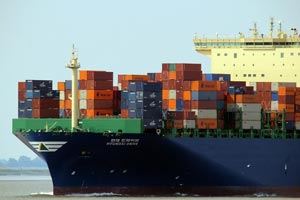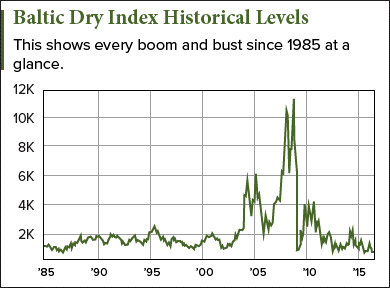An economic gauge that's highly contentious among investors and economists is the Baltic Dry Index (BDI). Some view it as an outdated index, while others see it as a strong predictive indicator of global economic growth.
Still, many investors don't fully understand the Baltic Dry Index and its significance.
Today, we're going to show you everything you need to know about the BDI. Then, we'll show you a stock whose shares could skyrocket 133% by next April thanks to the index's growing strength.
Here's everything you need to know about the BDI...
What Is the Baltic Dry Index?

Started in 1985, the Baltic index is a trade and shipping index based in London. It generally tracks the price changes in transport fees for raw materials around the world.
What Does the Baltic Dry Index Measure?
In a nutshell, the BDI measures the global shipping industry. More specifically, it follows the prices of several globally traded bulk commodities by compositing their tonnage fees on popular sea routes into a single index.
The commodities tracked by the BDI include coal, wheat, cement, iron ore, grain, and other raw materials considered fundamental to society. The sea routes that are tracked include the Panama Canal (tracked by the Panamax cargo ships) and Cape Horn (tracked by the Capesize ships).
But on the simplest economic level, the Baltic Dry Index measures supply and demand on a worldwide scale. When the BDI falls, it reflects falling global commodities sales and shipping prices. Since shipping is the main indicator of whether or not countries want goods, lower shipping prices can signal a weakening economy. After all, countries buy more goods when their economies are stronger and they have more money.
Why Is the Baltic Dry Index Important?
The Baltic Dry Index is important because it gauges global trading activity, which itself is a huge indicator of economic health.
Must See: Get a "Second Salary" with These Easy Investments
The BDI tracks the trading activity of only the most fundamental raw materials, such as coal and iron ore. These goods are significant because their global trade and prices have low speculation. Since these are only basic goods whose prices are often unaffected by geopolitical events, investors gain insight into core economic growth by watching the index's movement. If it moves higher, outlook on economic growth is positive. If it moves lower, the outlook is negative.
However, some investors don't consider the BDI a true indicator of economic health. This group of BDI detractors emerged in the wake of the 2008 financial crisis...
 You see, the financial crisis led to a glut of cargo ships, as many around the world sat dormant. These ships filled with raw materials stayed at their ports because the exporting countries didn't trust the credit of the importing countries.
You see, the financial crisis led to a glut of cargo ships, as many around the world sat dormant. These ships filled with raw materials stayed at their ports because the exporting countries didn't trust the credit of the importing countries.
This standstill bankrupted many shipping companies and caused the Baltic Dry Index to collapse. From May 2008 to December 2008, the BDI plunged a massive 93.9% from 11,648 to 711.
Even as the economy recovered, the index began to lose its appeal as an economic indicator. The biggest reason for this was China's surging cargo ship capacity, which was estimated to double from 2010 to 2013. That caused the global number of cargo ships to nearly double.
Because of this big supply injection of vessels, economists haven't been able to properly recalibrate the index. Since China never reported exactly how many ships it built from 2010 to 2013, the BDI might not be accounting for thousands of ships around the world.
Despite these drawbacks, some investors have renewed their interest in the Baltic index recently...
Over the last two years, the BDI has rebounded 107% to $1,243. This - along with Trump's proposed trade restrictions with China and other countries - has analysts more bullish on the shipping industry as a whole. On March 28, Morgan Stanley (NYSE: MS) analyst Fotis Giannakoulis said growing iron ore demand in China and strengthening rates on Capesize ships show the dry bulk market is becoming healthier.
Money Morning Resource Specialist Peter Krauth agrees that the BDI is still important, especially as shipping rates have surged more than 85% since February.
"When the BDI rises strongly, it suggests a tight market, where demand is robust while supply is limited," Krauth told Money Morning Members on April 12. "Lately, the BDI has been providing signals that the global economy is 'waking up.'"
And thanks to the strengthening BDI, Krauth has found one shipping stock that could vastly outperform the markets this year.
This company's stock price is very cheap right now, costing less than $8. And we expect it to skyrocket as much as 133% over the next year...
The Best Stock to Buy to Profit 133% from the Baltic Dry Index
[mmpazkzone name="in-story" network="9794" site="307044" id="137008" type="4"]
Consider Golden Ocean Group Ltd. (Nasdaq: GOGL) as the best way to play the revived shipping industry.
Golden Ocean is a Bermuda-based bulk shipping company with a fleet including all three carrier types tracked by the BDI. These are the Panamax, Capesize, and Supramax carriers. The firm boasts 77 vessels, many of which are less than four years old. And it owns another 45 vessels acquired when Golden Ocean bought two shipping firms for cheap after 2008.
The growth of its carrier fleet shows in the firm's recent earnings reports. In Q4 2016, Golden Ocean earned $0.06 per share on income of $6.5 million. That's a huge swing from the Q3 2016 loss of $0.25 per share on a loss of $26.7 million.
And investors have been buying into the company's dominance over other shipping peers. Shares of GOGL stock have soared 64.6% to $7.72 this year. Those gains beat other shipping stocks like Ship Finance International Ltd. (NYSE: SFL) and Frontline Ltd. (NYSE: FRO), which have lost 5.9% and 5.5% over the same period.
Analysts surveyed by Yahoo Finance see Golden Ocean stock soaring as much as 89.2% to $14 per share by April 2018. That would be if you buy in at the current price of $7.72.
But Krauth has a much more specific strategy for you...
He recommends waiting for the GOGL stock price to fall back to the $6-$6.50 range. Since the shipping sector is historically volatile and GOGL has already seen a big 64.6% gain in 2017, a short-term pullback would be normal at this juncture.
Once the stock dips to that range, a great buying opportunity will open up for investors.
And if you buy at the low end of that $6 range, you could see an even bigger return of 133% if shares hit $14 by next April. That would make Golden Ocean one of the best stocks to buy of 2017.
This "Secret" Helped Transform Two Teachers into Millionaires: Today Donna and Dave R. are retired millionaires who are also earning $10,000 a month in income. Much of their wealth is due to a Great Depression-era "program" most have no idea exists. Learn more...
Follow the author on Twitter @AlexMcGuire92.


